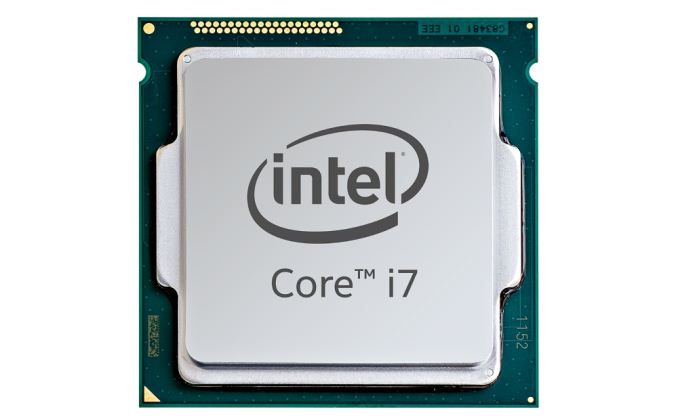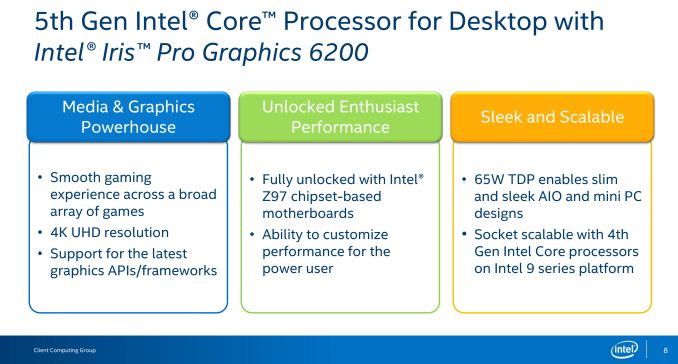The Intel Broadwell Desktop Review: Core i7-5775C and Core i5-5675C Tested (Part 1)
by Ian Cutress on June 2, 2015 7:45 AM ESTBroadwell-DT: Initial Thoughts
The new Broadwell desktop processors are somewhat out of sync with our regular expectations from Intel. Due to issues surrounding the 14nm node, as well as the cost, the whole Broadwell line from tablet to table-top has come out slower and more staggered than any Intel release in recent memory. As a result, the initial launch from Intel today is a pair of 65W desktop socketed models backed up with three 65W soldered down models whose true heritage is a chip primarily designed for large laptops and all-in-one devices.
Normally we would expect a range of desktop models from 35W up to 88W or higher, but socketed Broadwell-DT today only exhibits two units at 65W. This immediately puts a slight damper on those expecting to upgrade from Haswell’s high-end, or those wanting to go from something like a Pentium G3258 on Haswell to Broadwell’s top SKU. As a result, we have to keep our expectations in check – 65W should on paper perform nearly as well as an 88W part would, except it would be reduced by several hundred MHz. Meanwhile as these processors are also fully-unlocked and overclockable, we're left to ponder whether or not the stock frequencies actually matter in that case.
Due to the differential tangent at play, these processors also exhibit Intel’s best integrated graphics package, Iris Pro (GT3e), previously reserved only for soldered down/laptop/mini-PC orientations. This graphics package comes with largest number of execution units available from Intel, 48, alongside 128MB of eDRAM that acts almost like an L4 cache. This helps alleviate memory bandwidth pressure by providing a large(ish) pool near the CPU but with lower latency and much greater bandwidth than main memory. The eDRAM has the greatest effect in graphics, but we also saw some moderate increases in our non-3D regular benchmark suite.
The benefit of the graphics package, Iris Pro 6200, means that Broadwell-DT takes the crown as the fastest socketed graphics available. Our testing showed that the even the second-tier socketed SKU, the i5-5675C, outgunned the previous title holder, AMD’s A10-7870K. Despite having the i7-5775C in to test, due to time and firmware issues, we were unable to run the numbers on the integrated graphics but will do so in a later piece.
The key element to Broadwell-DT is not to consider it a natural successor to Haswell. It doesn't so much replace Haswell-K at this time, so much as it occupies a space Intel has left neglected since the launch of Haswell – the ultimate Intel integrated graphics solution. For users on integrated graphics, where money is no object, Intel now offers you the option to combine the regular CPU performance associated with Intel and a GPU that has the added performance benefits of on-chip, high-bandwidth eDRAM. The only question is whether that combined performance is worth the potential cost, and some would say no, pointing at a combined APU + GPU solution for equivalent or better gaming performance for the same price.
Pricing for the i5-5675C is listed as $276, slightly higher than the price of the i5-4690K which is at $236 on Amazon (reduced from $265). The i7-5775C is a bit higher at $366, also a margin higher than the i7-4790K which is $339 (reduced from $380). This makes Broadwell a tough sell right now in most circumstances unless you are absolutely limited to integrated graphics and want the best solution possible in a configurable PC. Given that Intel has also mentioned Skylake in their recent Computex keynote, it implements an abnormal situation that Intel has never been in with a new platform being talked about in the same breath. We have been told that these parts exist because users wanted them, and it has been interesting to see just how the added eDRAM changes the performance with discrete graphics in the mix.












196 Comments
View All Comments
ryrynz - Wednesday, June 3, 2015 - link
Fairly certain it's 64MB on more than one of them.Ryan Smith - Wednesday, June 3, 2015 - link
All GT3e parts have 128MB of eDRAM. Did we mess up and put the wrong value at some point in this article?patrickjp93 - Thursday, June 4, 2015 - link
No, you're right. 64MB version of Crystalwell is coming to Skylake only as far as I'm aware.Laststop311 - Wednesday, June 3, 2015 - link
Wow Intel wont even let AMD keep the better iGPU performance crown. At least APU's had higher gaming performance going for them. Now they really have nothing. Plus this part uses less power and runs cooler than amd's igpu. Intel's engineering and process advantage is really showing. If I was building an HTPC this chip would be my go to. Can actually play any game with decent settings on it. Turn ur HTPC into a console PC gaming machine as well.The_Assimilator - Wednesday, June 3, 2015 - link
"Now they really have nothing."Couldn't have put it better myself. APUs were AMD's last card, and Intel just took that card out vof AMD's hand. If Zen isn't the second coming that's been promised (and I doubt it because of AMD's marketing track record), then AMD's CPU division is effectively dead.
Oxford Guy - Saturday, June 6, 2015 - link
That's what Anandtech would have people believe. In reality the FX chips like the $100 8320E (I paid $133.75 with an 8 phase power motherboard from Microcenter) is very competitive for things like h.265 encoding, Blender, and so on with Intel -- especially on performance per dollar.So, Anandtech sticks 6 APUs in its charts and not a single 8 thread FX chip.
Oxford Guy - Saturday, June 6, 2015 - link
Example... top scoring APU in Cinebench multithread: 3258 thread FX at just 3.33 GHz: 540
at a more reasonable 4.28 GHz: 683
4.56 GHz: 724
4.78 GHz: 765
kevinkga - Wednesday, June 3, 2015 - link
I love it that you have a Linux section and I was even pleasantly surprised to see Redis benchmarks, which I use a lot! For my purposes I'm investigating using:1. MAXIMUS VII IMPACT MINI-ITX board (because it's the only ITX on the market afaik that supports M.2 x4. Other ITX boards seem to only support M.2 x2 although they often don't make it clear.)
2. Samsung XP941 128GB
3. M350 ITX case
4. Fedora 22 OS
xchaotic - Wednesday, June 3, 2015 - link
"Samsung XP941 128GB" - a bit small I think - best to get 256GB straight away.boozed - Wednesday, June 3, 2015 - link
A salient question perhaps, but I wouldn't go calling it a poignant one.